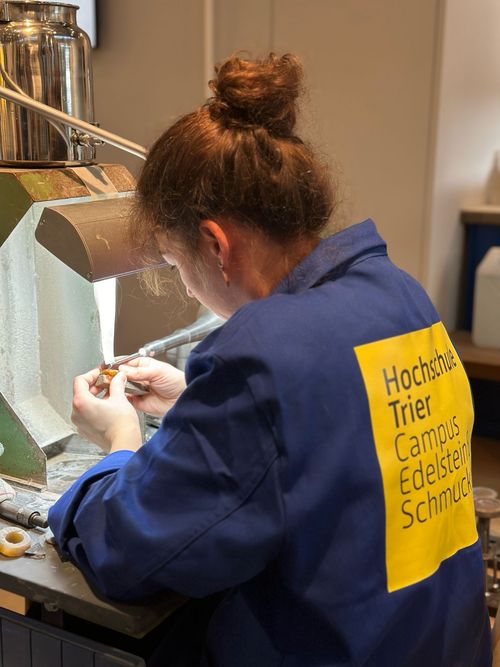The EXEMPLA special exhibition took place again this year as part of the Internationale Handwerksmesse in Munich. The Idar-Oberstein campus of Trier University of Applied Sciences was invited to provide an insight into gemstone processing techniques as part of the "living workshops" for this year's exhibition, "Natural Stone". Visitors to the exhibition were able to familiarize themselves with the craft of cutting and also try their hand at cutting.

The Internationale Handwerksmesse IHM takes place every year at the same time as the Munich Jewellery Week, where numerous jewelry artists from Germany and around the world come together in Munich to exchange ideas and build valuable networks. As the largest special show at the trade fair, EXEMPLA has been organized by the Handwerkskammer München und Oberbayern at the IHM since 1970. Under the direction of Barbara Schmidt, Angela Böck, Wolfgang Lösche and Michael Härteis, this year's theme was "Natural Stone", which covered 600 square meters of Hall B1. From coarse cobblestones to finely ground pigments, from stone kitchen fittings to sparkling gemstones, from massive blasting in the quarry to the precise setting of precious stones in the goldsmith's workshop, the theme of stone was omnipresent in its many facets. Traditional craftsmanship techniques as well as current and innovative trends in design craftsmanship and applied art were presented. IHM attracted more than 90,000 visitors this year.
The Idar-Oberstein campus of Trier University of Applied Sciences, which offers three Bachelor's and Master's degree courses in gemstones and jewelry, is unique in the world. The HWK München und Oberbayern invited the university to exclusively represent the topic of contemporary (art) jewelry with a focus on natural and precious stones at EXEMPLA. For this purpose, part of the stone workshop was transported from Idar-Oberstein to Munich and set up there as a "living workshop". Thanks to funding from the HWK, it was possible for teachers and students from Idar-Oberstein to travel to the trade fair to show visitors the craft of stone cutting on traditional machines and express their passion for gemstones and their processing. Visitors were also able to cut, engrave and facet their own stones and take them home as souvenirs. In addition to the artisanal techniques of stone processing, students' semester and graduation projects were also presented to illustrate the wide range of work produced in Idar-Oberstein.
Two further booths from Campus Idar-Oberstein were represented in Hall B1. The ASTONISH collective, consisting of Sharareh Aghaei (Iran), Adriana Almeida Meza (Colombia), Stephie Morawetz (Austria), Gina Nadine Müller (Germany), Vesal Bahmani Nik (Iran), Julia Obermaier (Germany) and Pei Wu (Taiwan), was founded in 2015 as a group of graduates from the university. Since 2016, they have been presenting their author's jewelry at national and international jewelry fairs.
The current group of graduates, POTATO, also showed their final projects in public for the first time this year. The six members, Bill Abu-Sakyi (Ghana), Julija Dobrojezzeva (Ireland), Erik Lijzenga (Netherlands), Helena Renner (Germany), Miriam Strake (Austria) and Ye Wang (China) had celebrated their exhibition debut a few weeks earlier at Inhorgenta and returned to Munich for the IHM.
Visitors to the fair showed great interest in the booths of the Idar-Oberstein campus. Thanks to the set-up, which created a workshop atmosphere that invited visitors to join in and also focused on the final projects created on campus, visitors were able to follow the path of the stones from rough stone to finished pieces of jewelry. Participation in the IHM therefore proved to be a complete success for the university, particularly in terms of evoking interest about the training opportunities in the stone and jewelry sector.
You are leaving the official website of Trier University of Applied Sciences